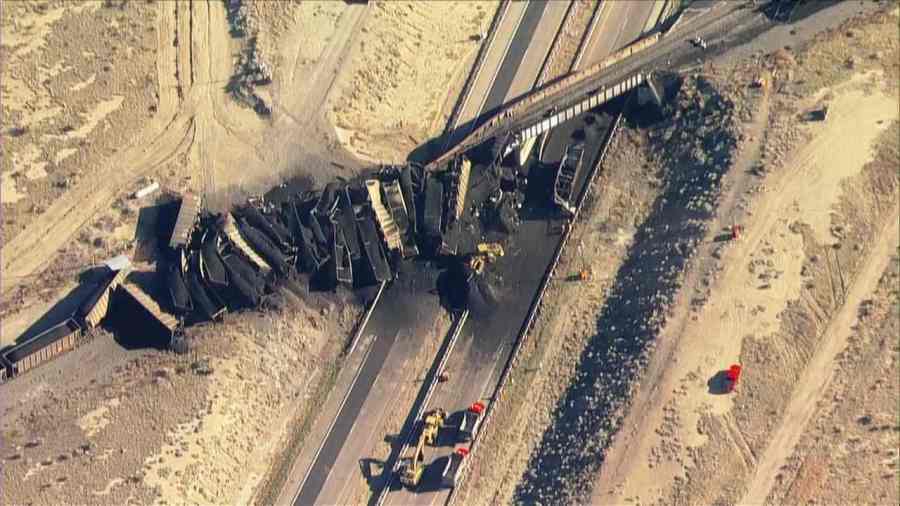Ohio Train Derailment: Investigation Into Long-Term Effects Of Toxic Chemical Contamination In Buildings

Table of Contents
Assessing the Extent of Contamination in Buildings
Determining the full extent of contamination in buildings following the Ohio train derailment is a complex and ongoing process. This requires meticulous testing and analysis to understand the scale of the problem and guide effective remediation strategies.
Testing Procedures and Challenges
Assessing contamination levels within buildings involves a multi-pronged approach. Methods include:
- Soil testing: Analyzing soil samples around buildings to identify the presence and concentration of hazardous chemicals.
- Air quality monitoring: Measuring the levels of volatile organic compounds (VOCs) and other hazardous substances in the air inside and around affected buildings.
- Water analysis: Testing water sources for contamination, including well water and municipal water supplies.
However, comprehensive testing faces significant challenges:
- Limitations of current testing methods: The complex mixture of chemicals released makes accurate quantification difficult. Some chemicals may be difficult to detect with current technology.
- Difficulties in accessing all affected buildings: Gaining access to all potentially affected properties for testing poses logistical and potentially legal hurdles.
- Need for long-term monitoring: The persistence of some chemicals in the environment requires continuous monitoring to assess the effectiveness of cleanup efforts and identify any potential resurgence of contamination.
Types of Chemicals Found and Their Health Risks
The derailment released a cocktail of hazardous chemicals, including:
- Vinyl chloride: A known carcinogen linked to liver cancer, brain cancer, and other serious health issues. Long-term exposure can lead to respiratory problems and immune system dysfunction.
- Butyl acrylate: An irritant that can cause skin and eye irritation, respiratory problems, and potentially more serious health problems with prolonged exposure.
The potential long-term health effects associated with these and other released chemicals include:
- Respiratory problems: Including asthma, bronchitis, and other lung diseases.
- Cancer risks: Increased risk of various cancers, depending on the specific chemical and level of exposure.
- Reproductive issues: Potential impacts on fertility and developmental problems in children.
- Neurological effects: Some chemicals can impact brain function, leading to cognitive impairment and other neurological disorders.
Further research is crucial to understand the synergistic effects of the chemical mixture.
Decontamination Efforts and Their Effectiveness
Decontamination efforts have included:
- Cleaning and removal of contaminated materials: This involves removing contaminated soil, debris, and other materials from affected properties.
- Air purification: Using specialized equipment to remove hazardous chemicals from the air within buildings.
- Water treatment: Treating contaminated water sources to remove hazardous substances.
However, the effectiveness of these efforts remains a subject of ongoing scrutiny. Challenges include:
- Challenges in complete removal of chemicals: Some chemicals may penetrate building materials, making complete removal extremely difficult.
- Long-term monitoring strategies: Ongoing monitoring is crucial to assess the long-term effectiveness of decontamination and identify any residual contamination.
Long-Term Health Effects on Residents
The Ohio train derailment has had profound impacts on the health and well-being of residents in East Palestine.
Observed Symptoms and Reported Illnesses
Residents have reported a wide range of symptoms since the derailment, including:
- Headaches: Frequent and intense headaches are a commonly reported symptom.
- Respiratory issues: Coughing, shortness of breath, and wheezing are prevalent.
- Skin irritations: Rashes, itching, and other skin problems have been reported.
- Gastrointestinal problems: Nausea, vomiting, and diarrhea have also been reported.
Establishing a direct causal link between these symptoms and chemical exposure is challenging due to pre-existing conditions and the complexity of the chemical mixture. Ongoing health monitoring programs are essential to track the long-term health impacts.
Mental Health Impacts of the Disaster
The derailment has also inflicted significant psychological trauma on the community:
- Anxiety and stress: Residents experience heightened anxiety and stress related to health concerns, environmental damage, and the disruption of their lives.
- Post-traumatic stress disorder (PTSD): The traumatic event may lead to PTSD in some individuals.
- Displacement and loss: Residents displaced from their homes face additional emotional and psychological distress.
Access to mental health resources and support is critical for the long-term recovery of the community.
Future Health Monitoring and Research
Long-term health monitoring programs are essential to track the health of affected residents over time. This includes:
- Regular medical checkups: Comprehensive medical examinations to monitor for the development of health problems.
- Biomonitoring: Testing of blood and other bodily fluids to detect the presence of hazardous chemicals.
- Epidemiological studies: Research to identify patterns of illness and disease among the affected population.
Collaboration between health professionals, government agencies, and research institutions is vital to understand the full spectrum of potential health consequences.
Environmental Impact and Remediation
The environmental consequences of the Ohio train derailment extend beyond the immediate vicinity.
Soil and Water Contamination
The derailment has led to significant soil and water contamination:
- Extent of environmental contamination: The extent of contamination is still being assessed, with ongoing testing of soil, water, and air samples.
- Impact on wildlife: Contamination poses a serious threat to wildlife in the area, potentially impacting the entire ecosystem.
- Long-term remediation efforts: Remediation of contaminated soil and water will be a lengthy and complex process.
Air Quality Monitoring and Future Risks
Air quality monitoring is crucial to assess potential long-term risks:
- Current air quality levels: While air quality has improved in some areas, ongoing monitoring is needed.
- Potential for long-term air pollution: The potential for long-term air pollution from residual chemicals requires continued surveillance.
- Need for continued monitoring: Regular air quality monitoring is necessary to identify any potential future pollution events.
Remediation Strategies and Challenges
Remediation strategies face significant challenges:
- Remediation techniques being used: A variety of techniques are employed, including soil excavation and treatment, groundwater remediation, and phytoremediation.
- Long-term environmental monitoring: Long-term monitoring of soil, water, and air quality is vital to ensure the effectiveness of remediation efforts.
- Challenges in complete remediation: Complete remediation may not be possible due to the complex nature of the contamination.
Conclusion
The Ohio train derailment's long-term consequences are profound and far-reaching. Thorough investigations are critical to understanding the full extent of toxic chemical contamination in buildings and the environment. Continued monitoring of residents' health, coupled with comprehensive environmental remediation efforts, are vital steps in addressing this ongoing crisis. We need sustained commitment to ensure the safety and well-being of the East Palestine community and prevent similar disasters in the future. Stay informed about the ongoing investigation into the Ohio train derailment and its long-term effects. Understanding the Ohio train derailment's impact is crucial for preventing future incidents and ensuring the health and safety of communities nationwide. Learn more about the long-term effects of the Ohio train derailment and advocate for improved safety regulations.

Featured Posts
-
 Nancy Mace Faces Angry Constituent Details Of The South Carolina Encounter
Apr 24, 2025
Nancy Mace Faces Angry Constituent Details Of The South Carolina Encounter
Apr 24, 2025 -
 Od Djevojcice Do Zene Rast Ella Bleu Travolte Kceri Johna Travolte
Apr 24, 2025
Od Djevojcice Do Zene Rast Ella Bleu Travolte Kceri Johna Travolte
Apr 24, 2025 -
 Are Wildfire Bets The New Normal The Case Of The Los Angeles Fires
Apr 24, 2025
Are Wildfire Bets The New Normal The Case Of The Los Angeles Fires
Apr 24, 2025 -
 Hong Kong Listed Chinese Stocks Rally Amidst Trade Truce Hopes
Apr 24, 2025
Hong Kong Listed Chinese Stocks Rally Amidst Trade Truce Hopes
Apr 24, 2025 -
 Cad Decline A Deeper Look At Recent Currency Movements
Apr 24, 2025
Cad Decline A Deeper Look At Recent Currency Movements
Apr 24, 2025
